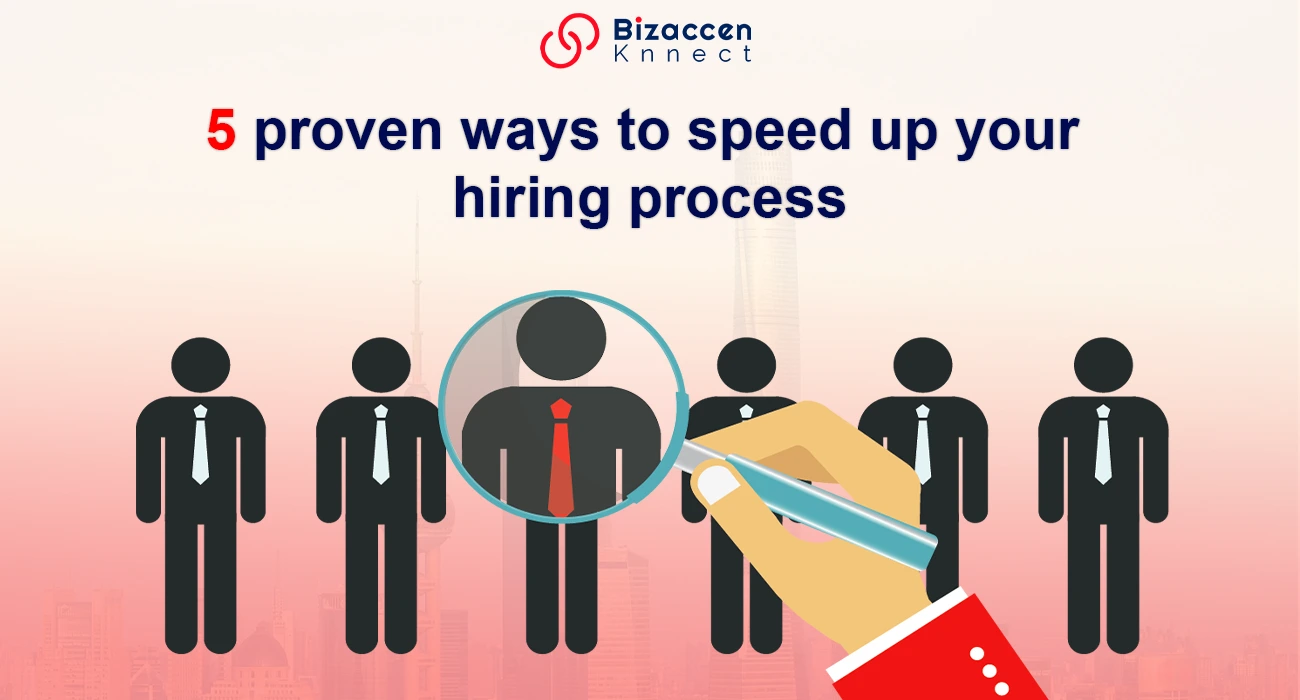
5 Proven Ways To Speed Up Your Hiring Process
 Bizaccenknnect
Bizaccenknnect
It is because of the employees that our business flourishes. This is why companies like Chick-fil are more and more focused on customer service with their employee training than anyone else in the industry. An inadequate man can damage a company’s reputation, and reputation is critical to a company’s success. Though the recruitment process can be lengthy and extensive, today we will talk about proven ways to speed up the recruitment process for the company.
The recruitment process in the company can take a lot of time and effort. In this job, a recruitment agency prioritizes a longer process in hiring the more qualified candidate for the company. Some job agencies do this job very fast and get better results in less time, and are also cost-effective.
Jobvite’s 2019 Recruiting Benchmark Report said that the average hiring process in the United States takes about 38 days. This number can be anywhere from 8.5 days for a delivery driver or closer to 54 days for a government employee. Now as an employer everyone knows that time is money, and will therefore look at proven ways to speed up the recruitment process. The recruitment process is one of the most important parts of success for any company. A bad employee can damage the reputation of the company and cost any company about 30% of that employee’s first year’s earnings.
As we see, the job market is becoming more and more competitive for organizations looking for new talent. More and more positions are opening up for recruitment than qualified applicants, and stellar candidates mostly have several offers to consider. So to speed up your company recruitment process, you can follow the simple steps given below:
1 Writing a Better Job Description
The best way to change your process is to start at the beginning: how are you talking about open positions? The purpose of giving a job description is not just to let people know about the job available to you, but the real purpose is to attract the right candidates. Plus it’s about setting the right expectations about the position and your company.
Whenever a position needs to be filled, hiring managers often push a candidate too hard to slow down and think about what kind of candidate they want and need. In the interest of time, they may not spend enough time developing an effective job description. The result is either a flood of ineligible candidates or a rush of candidates who can meet the super-specific demands. As an HR professional, you can be helped to improve the quality of applicants by having a candid conversation with the hiring manager about what you need to say in the job description.
Here are some things you should consider when preparing a job description with your hiring manager:
- 1. What are the 5 core skills a person needs to be hired for this job?
- 2. What would any person spend most of their time doing?
- 3. What tasks can they learn after being hired at your company?
- 4. How will your company measure success for this position?
- 5. How much experience should this person have?
- By creating a job description that gives an accurate reflection of the position along with the preferred and important qualifications. You cut out a lot of time spent screening and screening the details for you so that your funnel of candidates is narrower from the start.
2 Eliminate unnecessary steps in your recruitment process timeline
The more unnecessary steps you can cut out in your recruitment process, the more time you’ll save, thereby giving the best candidates more chances to beat the competition. A quick, easy recruitment process is just as important for candidates as it is for recruiters.
A 2016 research report by the Talent Board stated that 17 percent of all candidates who reported having a negative experience with an organization’s recruitment process withdrew their applications because the process took too long.
Here are some questions to consider when evaluating the stages of the hiring process in your company:
- 1. What can each step accomplish?
- 2. Can eliminating some steps change something in the description or ad placement?
- 3. What are the steps that create hurdles in the recruitment process?
- 4. Where do any candidates usually opt to exit the process?
- You can carefully audit your process and together you can determine which steps are pushing you forward and which are holding you back.
3 Counting of interviews of candidates
After you’ve screened your candidates, you’ll want to narrow the pool even further by interviewing them in person. Many organizations lose candidates due to poor interview practices during the interview process.
Let’s look at some of the most common interview pitfalls here:
Involving multiple stakeholders
For each candidate for the post of Graphic Designer, it may seem important to provide inputs to all the department heads that they are interested in. But think about it: Will all those ten people ever agree? By involving too many stakeholders, you can create an impassable conflict. A better way to gain group approval is to take input from people initially when you’re preparing a job description, then leave a small group to be the actual decision-makers.
Ineffective question
It can be a good icebreaker to ask a candidate what their spirit animal is, but it won’t give you too much information about how well they’ll do a job. To make each interview as comprehensive and meaningful as possible, don’t use “magic bullet” questions. They do not work. Use the targeted job description as a reference to what to ask in the interview.
No structure
When Manager A says that he liked the first candidate the most, does he have a good reason? To be effective, the response must go beyond gut feelings and hunches. And your interviews need structure if they are going to objectively evaluate different candidates and eliminate unconscious bias. It helps to prepare a list of questions and scorecards for each hiring manager before the interview process begins. When interviewing candidates each hiring manager can rank each candidate on elements such as culture fit, skill set, and whatever else matters. You can compare apples to apples by sticking to one question and using a consistent rating system.
Poor follow-up
Putting candidates through an interview, handing out scorecards to managers, and hoping it all happens together is not enough. To get the most out of your hiring process, you must follow up with managers and candidates while the interview is still fresh in their minds. Give hiring managers a chance to make and debrief notes from interviews, and notify candidates about the next steps. It can feel like grazing cats at times, but in the end, you’ll turn your interview process into a well-oiled machine.
4 Keeping communication channels open
There is no quick way to shoo someone away by giving them nothing but radio silence. This is known as “black hole syndrome” – when a candidate disappears into the funnel and hears nothing from the recruiting organization.
Schedule the communication from the beginning so that candidates can know:
- 1. How long can the application take
- 2. When you have received the candidate application
- 3. When candidates can expect to hear back from you
- 4. What is the Recruitment Process Timeline
- 5. How long could each step possibly take?
- Doing all this will not only make for a better candidate experience but also encourages candidates to stay tuned for the entire process. Even if it doesn’t allow you to advance as fast as your competitors.
Communication requires personal attention as well, especially for candidates who make it through the process. Interviews are stressful and making candidates feel comfortable with the welcome means they will be more of themselves during the actual interview.
As such, when a new candidate comes in for an interview they should be provided with water and kept in the company while they wait. Take the candidate on a guided tour of the entire office to see a snapshot of the office environment and help gain a better understanding of the company culture in action. When they visit the office with someone they already “know”, they may ask questions they may never have asked in an interview. Apart from this, you can also ask yourself if they want to work here. This helps both parties to know if they match.
5 Build a talent pool
Having an incredible candidate experience can help you speed up the recruitment process in the future as well. In a 2016 Talent Board report, 64 percent of candidates who reported a great recruitment process said they would enhance their relationship with the organization. It is not just talking about people who were hired. Most of these positive-reporting candidates weren’t even hired at the organizations they’re talking about.
If you can maintain a positive relationship with about two-thirds of all your candidates, including those you didn’t hire. This way you get a talent pool full of candidates who are already vetted, qualified and interested. Building a positive relationship with each of your qualified candidates means you can reduce your time for future jobs.
Conclusion
When it comes to speeding up your company’s recruitment and recruitment process with improvements, the best way to do it is to experience it firsthand. Be sure to “implement” your hiring managers and follow the new steps with you as you improve your process. Despite this, if you all find some steps confusing or lengthy, then chances are your candidates will do the same. For this, identify where you can reduce the cumbersome processes. You can also organize your work and improve communication with the help of job agencies. Making changes like the ones mentioned above can save an organization a huge amount of time and money, as well as start something great.

 Bizaccenknnect
Bizaccenknnect
Hello there! I simply would like to offer you a huge thumbs up for the excellent info you have got right here on this post. I will be returning to your blog for more soon.
A motivating discussion is worth comment. I believe that you ought to write more on this topic, it may not be a taboo matter but generally people do not talk about such issues. To the next! All the best!!
Excellent blog post. I certainly love this website. Keep it up!
Everything is very open with a clear clarification of the challenges. It was really informative. Your site is useful. Many thanks for sharing!
What i do not realize is in fact how you are no longer actually much more well-favored than you might be right now. You’re very intelligent. You recognize thus considerably in relation to this topic, made me in my view believe it from numerous numerous angles. Its like men and women are not fascinated until it is one thing to do with Lady gaga! Your own stuffs excellent. All the time handle it up!